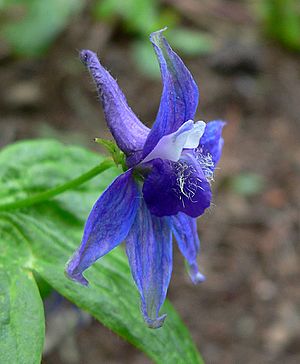Baker's larkspur facts for kids
Quick facts for kids Baker's larkspur |
|
|---|---|
 |
|
| Conservation status | |
| Scientific classification | |
| Genus: |
Delphinium
|
| Species: |
bakeri
|
Baker's larkspur, or Delphinium bakeri, is a special type of flowering plant. It is a perennial herb, which means it lives for more than two years and does not have a woody stem. This plant belongs to the buttercup family, called Ranunculaceae.
It is a very rare plant found only in California, United States. When a plant or animal is found only in one specific area, it is called endemic. Baker's larkspur is so rare that the government has listed it as an endangered species. This means it is in danger of disappearing forever. In 2006, only seven Baker's larkspur plants were left in the wild. They were found near Salmon Creek in Sonoma County.
Contents
What Baker's Larkspur Looks Like
Baker's larkspur grows from a thick, fleshy cluster of roots. It can grow up to about 70 centimeters (27 inches) tall. The leaves are mostly found along the top third of the stem. They are green when the plant flowers.
Its Unique Flowers
The flowers of Baker's larkspur have an unusual shape.
- They have five bright dark blue or purplish sepals.
- One sepal at the back is longer and forms a spur.
- The petals are not very noticeable and come in two pairs.
- The lower petals are oblong and blue-purple.
- The upper petals are slanted and white.
Seeds and Fruit
After flowering, the plant produces seeds. These seeds grow inside several dry fruits. These fruits have many seeds and split open on one side when they are ready. Baker's larkspur flowers from April through May.
Where Baker's Larkspur Lives
Baker's larkspur grows in soil made from broken-down shale. This type of soil is found within coastal scrub plant communities.
Historical Range
In the past, Baker's larkspur was found in more places. Its historical range included the Point Reyes Peninsula and areas between Camp Meeker and Petaluma, California. Today, it is much rarer.
See also
 In Spanish: Delphinium bakeri para niños
In Spanish: Delphinium bakeri para niños


